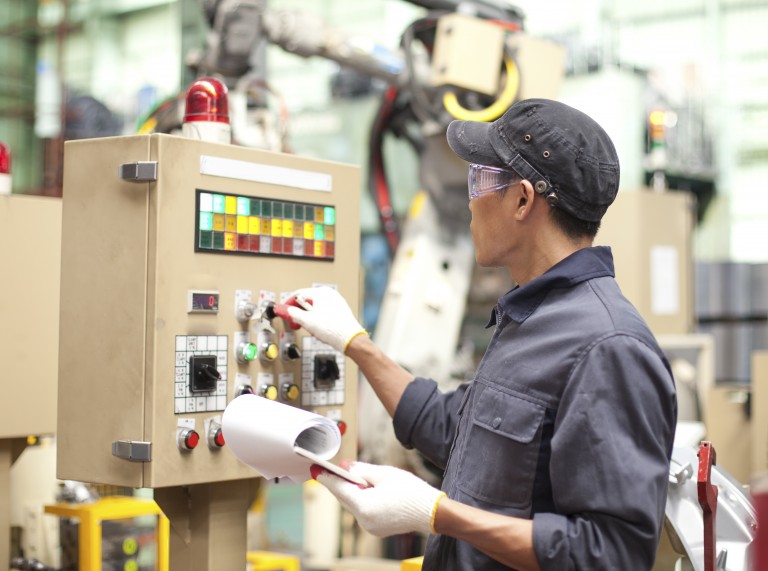The truth about which technology is best for your company
Often in discussions regarding factory performance measurements, regardless of whether the area that is being analyzed is the machines overall effectiveness (OEE), labor productivity and efficiency or part/job workflow speed, the words “Metrics” and “Analytics” are mentioned as a way to gather insight into process improvements. These terms represent technology that provides a way to view large amounts of data in some manner that helps management focus on areas of best practices and/or process improvement.
But these terms really mean different things and as long as you understand their meaning then you will not be misled into thinking that the software package you are considering to purchase can provide both. And this will allow your expectations to be in line with the software solution when it is installed.
Industrial engineer in factory
First let’s just eliminate the misconception that one of these technologies somehow is “better” than the other. Better is a relative word which is based on your requirements. In both Metrics software packages and Analytics software packages, visual representations (like charts and graphs) are available. Both analytical and metrics software solutions provide the ability to drill down through areas of focus as well as allow the visualization of large amounts of data history. This is common in both types of packages.
The major difference can best be stated by using the words…”cause” and “effect.” Metrics can show the effect of the production process into areas mentioned above…machines, labor, parts, workflow time, operations time, queue time, etc. The analysis of this information needs to be in the hands of a person that can use it to help try to find the cause of the problems/concerns or the reason for consistanly good performance; that is, the “who/what/when/where” of best practices in hopes of implementing thesemethods into other areas for process improvements.
For example, if I am having unusually high scrapping problems, then Metrics can identify the reasons for scrapping. In addition, a good metrics package can identify the machine, people and parts involved (assuming you have a good MES system to easily pick-up this data when scrap is reported).
Analytic packages can determine the cause for a specific effect.
The expectation of analytics is to allow the software to make these correlations within its technology borders and identify the “cause” by sifting through data and finding trends and patterns. For example, analytics can be used in the sales and marketing areas of the business that draw data from your website site visits and click, customer phone calls (CRM), market forecast, etc. Unlike the factory floor, this is often “Big Data,” that must use a sophisticated tool to help focus on areas of better product marketing.
In manufacturing there was published a recent article about how big data can improve manufacturing. Titled Manufacturers taking advantage of advanced analytics can reduce process flaws, saving time and money published in July 2014 by Eric Auschitzky, Markus Hammer and Agesan Rajagopaul does speak to an example of the use of Analytics in manufacturing…
“Even within manufacturing operations that are considered best in class, the use of advanced analytics may reveal further opportunities to increase yield. This was the case at one established European maker of functional and specialty chemicals for a number of industries, including paper, detergents, and metalworking…. As a result of these findings, the mine made minor changes to its leach-recovery processes and increased its average yield by 3.7 percent within three months—a significant gain in a period during which ore grade had declined by some 20 percent. The increase in yield translated into a sustainable $10 million to $20 million annual profit impact for the mine, without it having to make additional capital investments or implement major change initiatives.”
But in this article the authors mention that the results were from some very sophisticated technology. They stated…
”However, several unexpected insights emerged when the company used neural-network techniques (a form of advanced analytics based on the way the human brain processes information) to measure and compare the relative impact of different production inputs on yield.”
Neural-networks, as mentioned above, are not your everyday technology and to my point, Analytics is more than charts and graphic which are provided with a good Metrics package.
So before you make a decision on a metrics or analytical package, first ask yourself does your company have a good method of collecting the “results” in data files in a granular enough manner to expose all of the resources committed to an operational process…parts, machines, employees and do you have all the facts about reasons for downtime and scrap.
Start with a good MES that allows for a user friendly and easy way to collect this data. Then check out the Metrics provided. Put someone in charge of the Metrics that can do in depth evaluations of “causes.” Once the causes are identified then put corrective action methods into place. And after that, if you still think that an Analytical software product can still help just make sure you find a person that is knowledgeable in the use of such technology.
